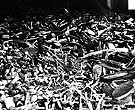
|
|
|

|

|

|

|
|
Click on an image to see a larger, more detailed picture.
|
|
|
|
|
| 1943: Death and Resistance |

|
pg. 417 |

|
|
|
|
| |
 Rita Rosani was a member of the Italian Resistance and the only Italian female resister known to have been killed in combat. Born in Trieste, Rosani was a schoolteacher at the local Jewish school until 1943, when she joined the Resistance. She met her death on September 17, 1944, after fighting in several actions in the Verona region.
Rita Rosani was a member of the Italian Resistance and the only Italian female resister known to have been killed in combat. Born in Trieste, Rosani was a schoolteacher at the local Jewish school until 1943, when she joined the Resistance. She met her death on September 17, 1944, after fighting in several actions in the Verona region.
Photo: YIVO / United States Holocaust Memorial Museum Photo Archive
|
 A vast pile of brushes, from women's hairbrushes to men's shaving brushes, attest to the Nazis' desire to rob those they executed of their most personal possessions. Hair became the raw material to stuff mattresses and weave cloth. Brushes were sold to consumers in Germany or distributed to soldiers at the front or in hospitals.
A vast pile of brushes, from women's hairbrushes to men's shaving brushes, attest to the Nazis' desire to rob those they executed of their most personal possessions. Hair became the raw material to stuff mattresses and weave cloth. Brushes were sold to consumers in Germany or distributed to soldiers at the front or in hospitals.
Photo: Panstwowe Muzeum Oswiecim
|
 Joint Rescue Committee
Joint Rescue Committee
Despite the odds, this committee of the Jewish Agency for Palestine was determined to obtain information concerning Jews imprisoned in Polish ghettos. The Joint Rescue Committee, based in Jerusalem, wanted to send these Jews food parcels. The members also wanted to help them, should they manage to escape from the Nazis, to obtain immigration certificates to Palestine. Early leaders of the committee were Itzhak Gruenbaum (pictured), Moshe Shapira, Eliyahu Dobkin, and Emil Schmorak. Gruenbaum felt that because the Nazis were so formidable, because the Allies were indifferent to the Jewish plight, and because no significant resources stood behind the committee that nothing the committee did could significantly help the Jews trapped in Nazi Europe. Instead, Gruenbaum believed they should focus on establishing Palestine as a home for the Jewish survivors after the war. By 1945 the committee was devoting all of its efforts to establishing a Jewish state in Palestine.
Photo: Yad Vashem
|
|

|

|

|

|
 January 17, 1943: Berlin Bishop Konrad Graf von Preysing is the only top German Catholic prelate who consistently opposes the German government's Jewish policies. Preysing threatens Pope Pius XII, saying he will resign unless the collaborative behavior of the other German bishops ceases.
January 17, 1943: Berlin Bishop Konrad Graf von Preysing is the only top German Catholic prelate who consistently opposes the German government's Jewish policies. Preysing threatens Pope Pius XII, saying he will resign unless the collaborative behavior of the other German bishops ceases.
|
 January 18, 1943: Jewish deportees from Belgium arrive at Auschwitz, where 1087 are gassed.
January 18, 1943: Jewish deportees from Belgium arrive at Auschwitz, where 1087 are gassed.
|
 January 18, 1943: After a four-month break, Germans resume deportations from the Warsaw Ghetto. Warsaw Jews react with their first acts of overt resistance, expressed in brutal street fighting. 1000 Jews are executed in the streets and 6000 are deported to the Treblinka death camp. An elderly, blind Jewish man is shot by an SS man because he is unable to walk without a guide.
January 18, 1943: After a four-month break, Germans resume deportations from the Warsaw Ghetto. Warsaw Jews react with their first acts of overt resistance, expressed in brutal street fighting. 1000 Jews are executed in the streets and 6000 are deported to the Treblinka death camp. An elderly, blind Jewish man is shot by an SS man because he is unable to walk without a guide.
|
 January 18, 1943: Nobel-prize winning Polish émigré poet Czeslaw Milosz--a righteous Christian--condemns antisemitism and nationalism as "ills that like cancer were consuming Poland." In his poem, "Campo dei Fiori," Milosz laments from Warsaw in 1943--and he's being literal, not figurative--that the carousel's carnival tunes and the laughing crowds in the Catholic area of Warsaw drown out the sounds of the Germans shooting Jews in the Warsaw Ghetto.
January 18, 1943: Nobel-prize winning Polish émigré poet Czeslaw Milosz--a righteous Christian--condemns antisemitism and nationalism as "ills that like cancer were consuming Poland." In his poem, "Campo dei Fiori," Milosz laments from Warsaw in 1943--and he's being literal, not figurative--that the carousel's carnival tunes and the laughing crowds in the Catholic area of Warsaw drown out the sounds of the Germans shooting Jews in the Warsaw Ghetto.
|
|
|
|
|
| 1943: Death and Resistance |

|
pg. 417 |

|
|
The Holocaust Chronicle
© 2009 Publications International, Ltd.
|
|
